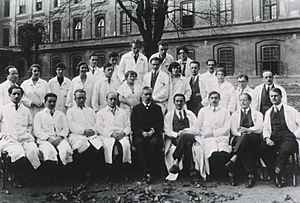Edith Klemperer facts for kids
Edith Klemperer (born August 9, 1898 – died September 23, 1987) was a pioneering doctor from Vienna, Austria. She was one of the first women to become a specialist in neurology (studying the brain and nerves) and psychiatry (helping people with mental health). Later, in the United States, she became famous for using hypnosis to help people. She earned her medical degree in 1923 from the Medical University of Vienna.
Dr. Klemperer continued her important research in Vienna. In 1927, she was one of six women doctors working with Julius Wagner-Jauregg when he won the Nobel Prize in Physiology or Medicine. Because of the difficult political situation and their Jewish heritage, Dr. Klemperer and her colleagues were forced to leave Austria when the Nazis came to power. Among them were Dr. Alexandra Adler, who became a leading neurologist at Harvard University, and Dr. Annie Reich, a famous psychoanalyst in New York.
Edith Klemperer's Amazing Brain Model
Dr. Klemperer escaped from Austria and arrived in New York in September 1939. She came with very little, but she brought her amazing neon model of the human brain. She invented this "Luminous Brain" in 1931 and patented it in 1934.
This special model was designed to show how the brain's electrical signals work. It helped medical students and the public understand the brain better. Popular Science magazine described it as being "entirely made of glass," with "hundreds of tubes" shaped like different parts of the brain.
Using an electric switchboard, the model could show how thoughts flash, how automatic movements like breathing happen, and even how mixed-up signals can occur in some mental illnesses.
Klemperer's Luminous Brain was part of a trend of cool 3D models. These models were made to be both beautiful and educational. For example, the "Transparent Man" was a 3D model of the human body. It attracted huge crowds at the Chicago World's Fair in 1933.
Today, scientists still create 3D brain models. They use light to show the brain's electrical activity. One example is "Glassbrain Flythrough 2015." It uses data from MRI scans and EEG tests to create a detailed view of the brain.
Research and Helping People with Hypnosis
While working in Vienna, Dr. Klemperer wrote 24 research papers. Some of her work looked at the chemistry of blood and brain fluid in people with brain problems. She also studied how the body responds to hypnosis.
In the 1940s, Dr. Klemperer worked as a senior psychiatrist at Bellevue Hospital in New York. After that, she became a leader in using hypnotherapy to help people. As early as 1953, she used hypnosis to help people stop smoking.
In the 1950s and 1960s, she published many papers about hypnosis. She wrote about how to use hypnosis, how it affects a person's self-image, and how it can help people change. She also gave lectures to other doctors about her work.
In 1968, she published her book called Past Ego States Emerging in Hypnoanalysis. This book shared her deep knowledge of using hypnosis to understand and help people.



